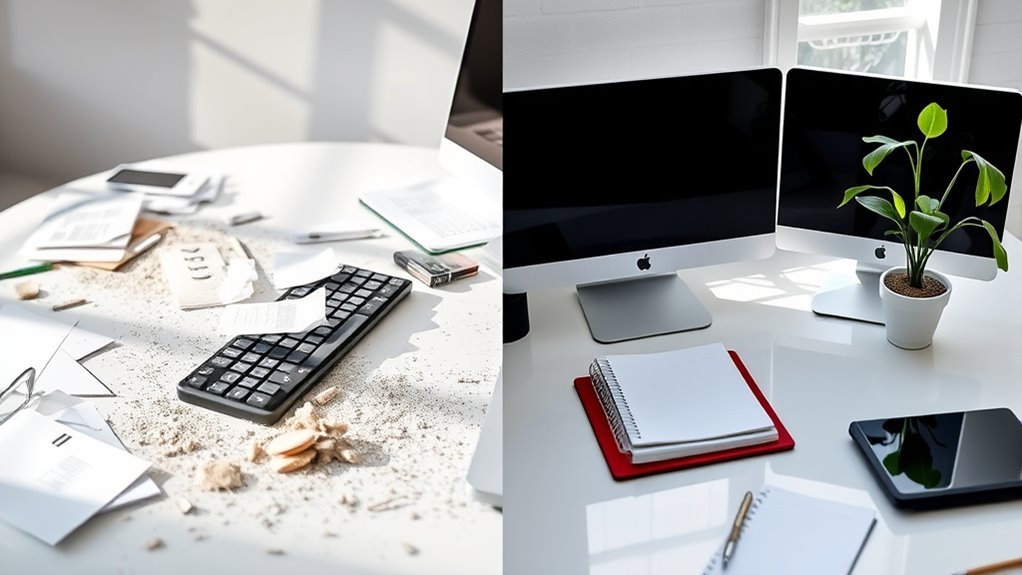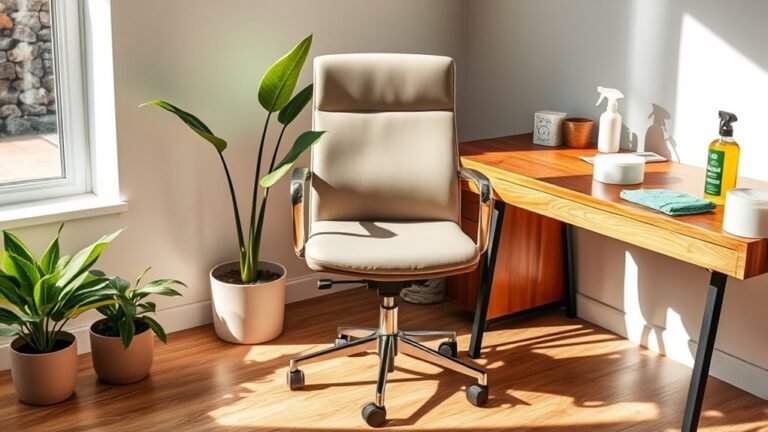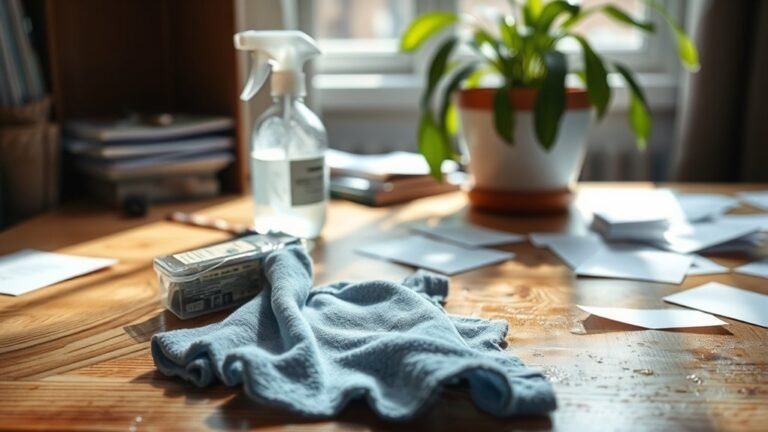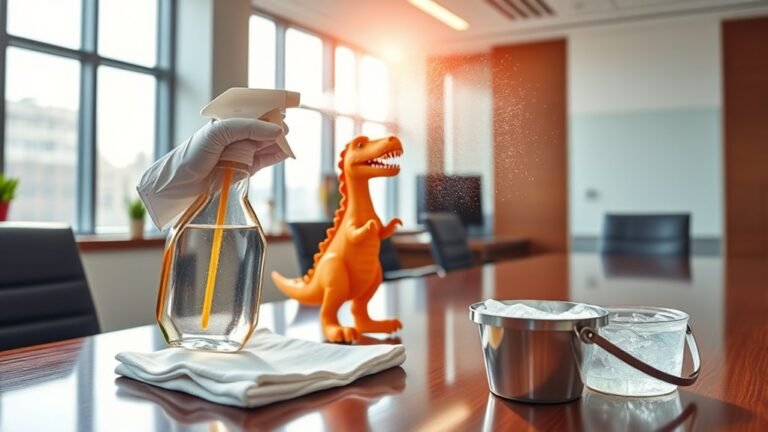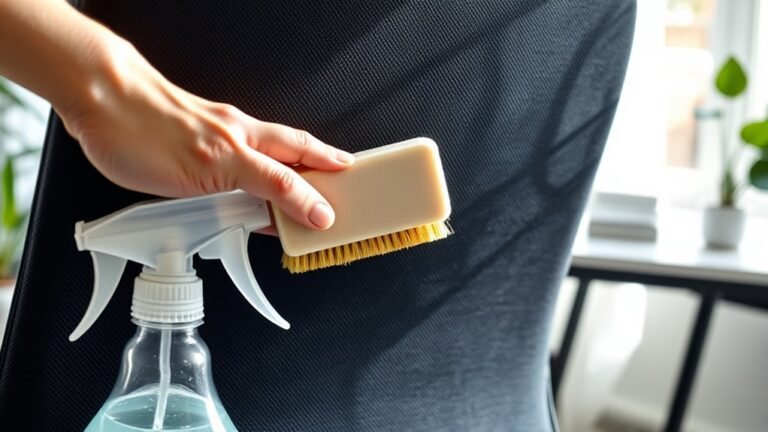Cleaning Tips Before and After Desk
You’ll want to start your day by decluttering your desk, keeping only essentials within reach to boost focus. Regularly dust with a microfiber cloth and disinfect high-touch spots like your keyboard and mouse to stay germ-free. Keep cleaning supplies handy for quick surface wipes throughout the day. In the evening, spend a few minutes organizing papers and tidying cables to prepare for tomorrow’s work. These simple habits can transform your workspace—there’s plenty more ways to create a productive, stress-free environment.
Importance of Cleaning Your Desk Regularly
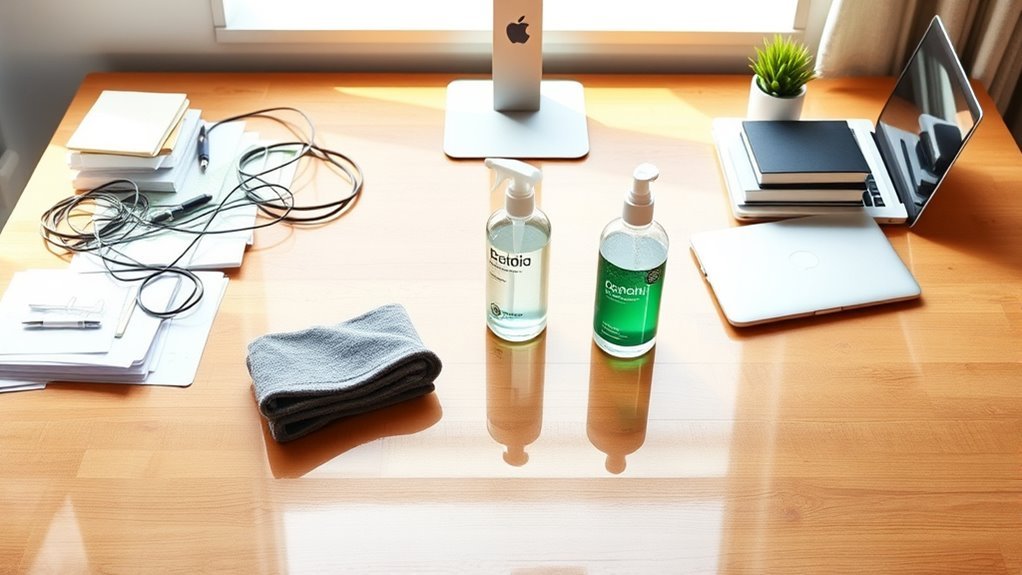
Although it might seem like a small task, cleaning your desk regularly plays an essential role in maintaining your productivity and focus. When you prioritize desk hygiene, you create a clear, inviting space that helps you think freely without distractions. A cluttered, dirty desk can weigh you down, making it harder to stay motivated and concentrate on your goals. By keeping your workspace tidy, you’re not just organizing; you’re setting yourself up for a productivity boost that lets you work smarter, not harder. This simple habit supports your desire for freedom—freedom from chaos, stress, and wasted time. So, take a few moments each day to clean your desk, and you’ll notice how much more control you gain over your workflow and mindset.
Essential Cleaning Supplies for Desk Maintenance
Keeping your desk clean is easier when you have the right tools at hand. To maintain a clutter-free, fresh workspace that lets you focus and feel free, gather essential cleaning supplies. These will help you quickly tackle dust, spills, and messes without hassle. Consider having:
- Microfiber cloths for wiping surfaces gently and effectively
- Multipurpose spray cleaner safe for various desk materials
- Compact cleaning gadgets like keyboard brushes and screen wipes
- Desk organizers to keep supplies and papers neatly arranged
With these items, you’ll streamline your cleaning routine and keep your desk inviting. You’re not just tidying up—you’re creating a space that supports your productivity and freedom. These essentials guarantee you’re always ready to clean effortlessly, so distractions don’t hold you back.
How to Declutter Your Desk Before Starting Work
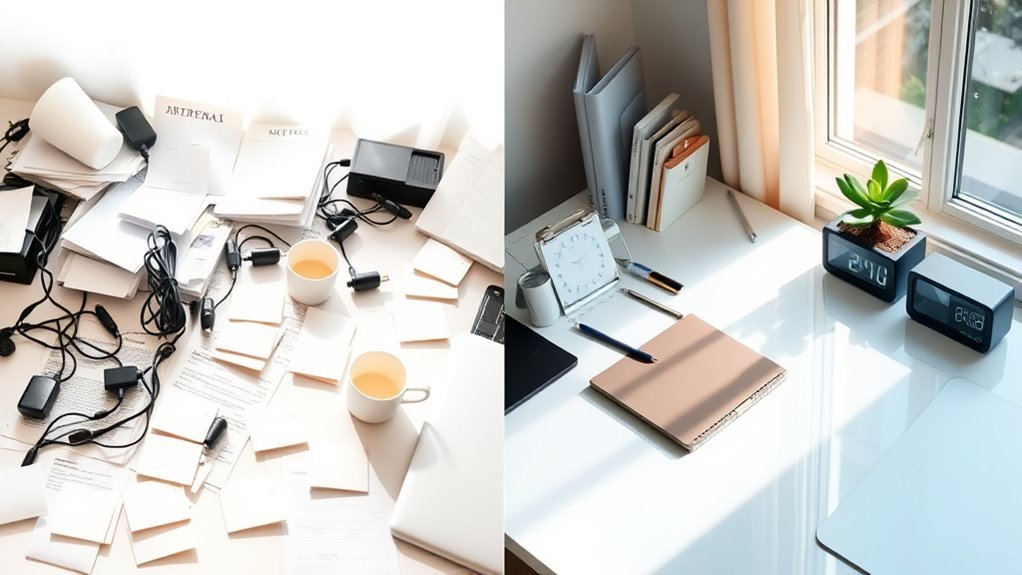
Before you start working, take a moment to sort through your desk and keep only the essentials within reach. Clear away anything that doesn’t serve your current tasks to create a clean workspace. Then, organize your work supplies so everything has its place and is easy to find.
Sort Essential Items
Start by identifying the five essential items you need on your desk to stay productive. This step is vital for clear item categorization, helping you focus on desk essentials that support your workflow while freeing up space. Keeping only what’s necessary empowers you to work without distraction.
Consider these key categories when sorting:
- Writing tools (pens, pencils)
- Notepads or planners
- Electronics (laptop, charger)
- Organizational tools (folders, trays)
Remove Unnecessary Clutter
Once you’ve sorted out the items you truly need, it’s time to clear away everything that doesn’t belong on your desk. Embrace a minimalist workspace by removing anything that distracts you or clutters your mind. This isn’t just about physical stuff; digital declutter matters too. Delete or archive unnecessary files, emails, and shortcuts. Freeing your space helps free your mind, making your work smoother and more focused.
| What to Remove | Why It Matters |
|---|---|
| Old papers | Prevents distraction |
| Unused gadgets | Clears physical space |
| Excess cables | Reduces visual chaos |
| Digital junk files | Speeds up device performance |
| Unnecessary apps | Keeps focus on essentials |
Decluttering creates room for creativity and peace, allowing you to work with freedom.
Organize Work Supplies
Three simple steps can transform your workspace by organizing your work supplies effectively. Embracing desk organization frees you from distractions, letting creativity flow. Start by sorting your supplies, keeping only essentials within reach. Use containers or drawer dividers for neat supply management. Label everything to quickly find what you need, saving time and mental energy. Consider these quick tips:
- Group similar items together
- Store frequently used tools in accessible spots
- Use vertical space like shelves or pegboards
- Regularly reassess your supplies to prevent buildup
Effective Dusting Techniques for Desk Surfaces
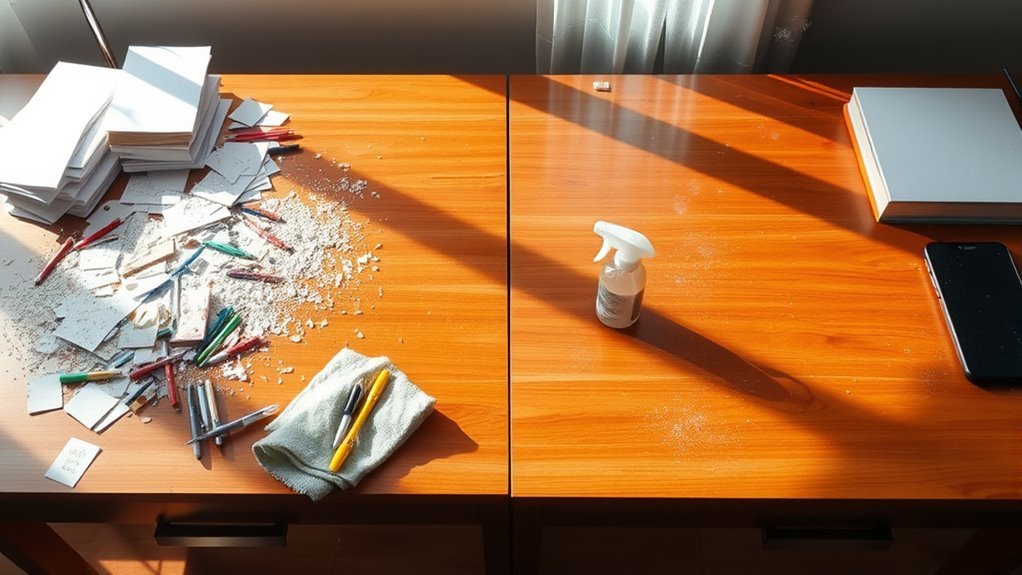
To keep your desk dust-free, picking the right cloth is key—microfiber works wonders without scratching surfaces. You’ll want to dust regularly to prevent buildup, but be gentle around delicate items to avoid damage. Let’s look at how often to dust and the best ways to handle fragile things on your desk.
Choosing the Right Cloth
Picking the right cloth can make a huge difference when dusting your desk. Microfiber cloths are a top choice because they trap dust without spreading it around, letting you clean effortlessly. If you want to keep things eco friendly, consider reusable options that reduce waste and last longer. Here’s what to look for when choosing your cloth:
- Soft texture to avoid scratching surfaces
- High absorbency for picking up dust and spills
- Durable material for repeated use
- Easy to wash and maintain
Dusting Frequency Tips
Once you’ve selected the right cloth, the next step is figuring out how often you should dust your desk. Your dusting schedule really depends on your environment and how much time you spend at your desk. If you want to keep things feeling fresh and free from allergens, aim to dust at least once a week. In busier or dustier spaces, you might need to dust more frequently. Using the right dusting tools, like microfiber cloths or electrostatic dusters, makes the process quicker and more effective. Don’t overthink it—create a routine that fits your lifestyle and stick to it. Keeping your desk dust-free not only boosts your focus but also gives you the freedom to work in a clean, inviting space every day.
Handling Delicate Items
Although dusting your desk is important, handling delicate items requires extra care to avoid damage. When cleaning, you want to maintain your freedom to move and organize without worrying about fragile belongings. Here’s how you can guarantee careful handling:
- Use a soft microfiber cloth to gently remove dust without scratching surfaces.
- Avoid harsh chemicals; opt for mild cleaners safe for delicate finishes.
- Lift items instead of dragging them to prevent accidental damage.
- Take your time, especially with items like glass ornaments or electronic devices.
Disinfecting Your Desk to Prevent Germs
Because your desk is a hotspot for germs, regularly disinfecting it is essential to maintain a healthy workspace. Focus on germ hotspots like your keyboard, mouse, phone, and desk surface—these areas collect bacteria and viruses fast. Choose disinfection methods that suit your lifestyle, such as alcohol-based wipes or sprays with at least 70% alcohol. You can also use disinfectant solutions safe for electronics to avoid damage. Make it a habit to wipe down these areas daily or whenever you notice dirt. This simple routine frees you from worrying about germs and keeps your environment fresh and inviting. Disinfecting isn’t just about cleanliness—it’s about creating the freedom to work confidently without health distractions. Your desk deserves that kind of care.
Organizing Cables and Electronic Devices
Keeping your desk disinfected is a great start, but tangled cables and cluttered devices can still make your workspace feel chaotic. To truly enjoy a clean, free environment, focus on cable management and device organization. Here’s how you can reclaim your space:
- Use cable clips or sleeves to bundle wires neatly.
- Label each cable for quick identification.
- Store seldom-used devices in drawers or designated containers.
- Position frequently used electronics within easy reach but off the main surface.
Cleaning Your Desk Chair and Surrounding Area
While you focus on tidying your desk, don’t forget to clean your chair and the area around it, as dust and dirt can easily accumulate there. Proper chair maintenance not only extends its life but also keeps your workspace inviting. Pay attention to the fabric or leather, use a vacuum or damp cloth, and wipe down hard surfaces. Surrounding cleanliness matters too—clear crumbs, dust, and debris from under and around your chair to create a fresh environment.
| Task | Frequency | Tools Needed |
|---|---|---|
| Vacuum chair fabric | Weekly | Vacuum with brush |
| Wipe armrests | Weekly | Damp cloth |
| Clean chair wheels | Monthly | Brush, cloth |
| Sweep under chair | Weekly | Broom or vacuum |
| Disinfect surfaces | Biweekly | Disinfectant wipes |
Stay free and focused with a clean chair and space!
Tips for Maintaining a Clean Desk Throughout the Day
A few simple habits can help you maintain a clean desk throughout the day. Keeping your workspace tidy isn’t just about looks—it’s a key to desk organization that fuels a productivity boost. Here’s how you can stay on top of it:
- Set a 5-minute timer every hour to clear clutter.
- Use trays or containers to keep essentials neat and accessible.
- Limit what you keep on your desk to reduce distractions.
- Wipe surfaces quickly when you notice dust or spills.
Evening Desk Cleanup Routine for a Fresh Start Tomorrow
Before you leave your workspace, taking a few minutes for an evening desk cleanup can make a big difference in how you start your next day. Establishing a simple evening routine helps you clear clutter, organize documents, and put away supplies, setting the stage for a fresh start. You’ll feel less overwhelmed when you return, ready to focus on what matters most. Keep only essentials on your desk, wipe down surfaces, and file away loose papers. This small habit frees your mind and space, giving you control and a sense of freedom. By ending each day with intentional tidying, you create an environment that invites productivity and calm, making your mornings smoother and your workflow more enjoyable.
Frequently Asked Questions
How Often Should I Deep Clean My Computer Keyboard?
If you don’t deep clean your keyboard, it might just turn into a mini jungle of crumbs and mystery gunk faster than you can blink! For proper keyboard maintenance, aim to deep clean it every one to two months. This cleaning frequency keeps your keys feeling fresh and your device running smoothly. You’ll feel so free knowing your keyboard’s not harboring hidden dirt—plus, it’ll last longer and work better!
Can Natural Cleaning Products Damage My Desk Surface?
You might think natural cleaning products are always safe, but they can damage your desk surface if the natural ingredients aren’t compatible. It’s important to check surface compatibility before using anything, even if it’s natural. Some oils or acidic components can harm finishes or wood. So, to keep your freedom to clean without worry, always test a small hidden spot first and choose products that suit your desk’s material.
What’S the Best Way to Clean Desk Drawers?
When cleaning desk drawers, start by emptying them completely to get a fresh slate. Use gentle cleaning supplies like a mild detergent and a soft cloth to wipe away dust and grime. While you’re at it, consider drawer organization tools like dividers or small bins to keep things tidy. This way, you’ll create a clutter-free space that feels freeing and lets you find what you need without hassle.
How Do I Remove Sticky Residue From Desk Surfaces?
When you’re tackling sticky residue removal, start by gently rubbing the area with a cloth dipped in warm, soapy water. If that doesn’t cut it, try adhesive residue solutions like rubbing alcohol or a bit of vinegar—they work wonders without harsh chemicals. Just apply a small amount, wait a minute, then wipe clean. You’ll free your desk surface from sticky messes, making it look fresh and ready for whatever you want to create next.
Should I Clean My Desk Differently Based on Material Type?
Yes, you should clean your desk differently depending on its material. For wood care, avoid harsh chemicals; use a gentle wood cleaner or a mix of water and vinegar to keep it looking natural and protected. When it comes to glass maintenance, a streak-free glass cleaner or diluted rubbing alcohol works wonders. Tailoring your cleaning approach lets you maintain your desk’s unique vibe, giving you the freedom to enjoy a clean, well-kept workspace.
